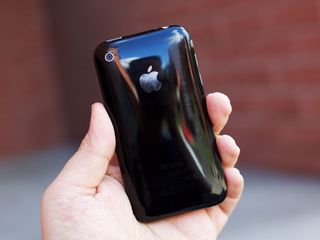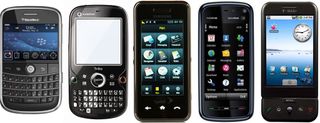History of iPhone 3G: Twice as fast, half the price

At WWDC 2008 on June 9, after finalizing the details of the upcoming App Store, and summing up the original iPhone's achievements, the late Steve Jobs] dove into the next set of challenges Apple had to face. On the surface, they were obvious even before Jobs bullet-pointed them on stage: 3G, Enterprise, third-party apps, more countries, and being more affordable. The software changes came as part of iPhone OS 2.0. The hardware, iPhone 3G.
Just one year after launching the iPhone, we're launching the new iPhone 3G that is twice as fast at half the price. iPhone 3G supports Microsoft Exchange ActiveSync right out of the box, runs the incredible third party apps created with the iPhone SDK, and will be available in more than 70 countries around the world this year.
More for less
The iPhone 3G, codenamed N82 and device number iPhone1,2, had the same 3.5-inch screen at 320x480 and 163ppi as the original. The cellular radio, however, received a significant update to support 3G UMTS/HSPA networks. That allowed for a much faster theoretical download speed of 3.6 mbps. Jobs claimed it was 36% faster than the other leading 3G phones of the time, including the Nokia N95 and Palm Treo 750, while also rendering a better version of the web.
The Dock connector remained, but Apple changed some of the pins so it no longer supported charging over FireWire, which rendered some accessories incompatible. It had the same Bluetooth 2.0 + EDR and 802.11 b/g Wi-Fi as well, but added an aGPS (assisted global positioning system) chip for more precise location services.
As the model number suggested, however, Apple didn't consider the iPhone 3G as full, next generation update. It was the first model, take two. That was probably due to the chipset remaining the same, an ARM-based, Samsung manufactured 1176JZ(F)-S processor and PowerVR MBX Lite 3D graphics chip, with 128MB of RAM that was already showing its age and limitations. Storage options also remained at 8 and 16GB for NAND Flash. Likewise sensors and cameras. Curiously, the battery dropped to 1150 mAh, though not at the expense of battery life.
There was still no CDMA and EVDO Rev A model either, which meant still no possibility for Verizon or Sprint. Since Apple remained exclusive to AT&T, it didn't much matter.
There was, however, something that did change and in a major way: the design.




Instead of the original aluminium casing with plastic buttons, Apple went with a polycarbonate casing with metal buttons. That let them improve RF transparency, which made for better reception, and also to offer some variety. While the front plate remained uniformly black the 16GB had a backplate offered in both black and white.
Master your iPhone in minutes
iMore offers spot-on advice and guidance from our team of experts, with decades of Apple device experience to lean on. Learn more with iMore!
It didn't look quite as high-end as the original, and had some issues with hairline cracks around the cutouts, but it did manage to be both sturdy and reliable. It was also rounded instead of flat on the back, allowing Apple to call it thinner at the edges.
Improved audio and a "fixed" headphone jack that was flush mounted and thus compatible with almost all headsets rounded out the updates.
But there was one more giant different—the price.
Jobs said that, according to Apple's research, 56% of potential iPhone customers didn't buy because of the price. Yet the value of the iPhone and it's ability to drive adoption of premium services had been proven to carriers. So, Apple was able to convince the carriers to front a significant portion of the price.
It dropped from a whopping $499/$599, on contract, to a much more enticing $199/$299.
Apps for that
Three months before the iPhone 3G's introduction, on March 8, 2008, Apple held the iPhone SDK event. There, Steve Jobs announced not just iPhone OS 2.0, but the software development kit, and the App Store. It was the first indication of how Apple planned to handle updating the iPhone and turning it into a full-on platform.
Apple had discussed using OS X's AppKit or Safari's WebKit as an interface layer, but ultimately went with something new—UIKit. And so Henri Lamiraux's team, fresh off the forced-march required to launch the original iPhone, went on another one to get the software development kit (SDK) ready for iPhone OS 2.0.
From Apple:
We're excited about creating a vibrant third party developer community with potentially thousands of native applications for iPhone and iPod touch. iPhone's enterprise features combined with its revolutionary Multi-Touch user interface and advanced software architecture provide the best user experience and the most advanced software platform ever for a mobile device.
The iPhone many people had been waiting for
The iPhone 3G launched on July 11, 2008, and it launched internationally. By the end of the year, it reached 70 countries. Apple also launched iPhone OS 2.0, the App Store, and MobileMe on the same day, something that overwhelmed so many servers for so long Apple has since switched to releasing software updates a couple days before hardware.

That didn't slow sales, however. Over a million people bought the iPhone 3G the first weekend alone. From Apple:
iPhone 3G had a stunning opening weekend.It took 74 days to sell the first one million original iPhones, so the new iPhone 3G is clearly off to a great start around the world.
Reviews were likewise enthusiastic, even with some reservations. Ed Baig, writing for USA Today:
It's cheaper, faster and a lot friendlier for business. Apple's blockbuster smartphone already had nifty features such as visual voicemail, a splendid built-in video iPod and the best mobile Web browser I've ever used. With GPS newly added to the mix, this handheld marvel has no equal among consumer-oriented smartphones.
Jason Snell, writing for Macworld:
If you've been cautious and waited a year for the second generation of iPhone, your patience will be rewarded. The iPhone 3G improves on the original iPhone's audio quality, offers access to a faster data network, and sports built-in GPS functionality. You'll also be getting in on the ground floor of the exciting new world of third-party software written for the iPhone. And business users will appreciate the iPhone's new Exchange syncing features.
Those who bought the iPhone 3G that first weekend, and those who updated their original iPhones, could not only launch Safari or SMS, but could download and use Facebook, play Super Monkey Ball, and so much more.
By September 9, 2008, more than 3,000 apps were available in the App Store, including 600 free apps. The App Store, combined with the price drop, began the momentum that would drive the iPhone for year's to come. And would drive the mainstreaming of the smartphone.
Partners... and competitors
The existing, entrenched smartphone vendors of the time, Microsoft, Palm, RIM (BlackBerry), and Nokia spent 2008 not much differently than they'd spent 2007. They talked a lot, but none of them showed a single sign that they realized the iPhone had absolutely changed everything on the market.

Mike Lazaridis, former co-CEO of RIM/BlackBerry
I couldn't type on the [iPhone] and I still can't type on it, and a lot of my friends can't type on it. It's hard to type on a piece of glass.
Ivan Seidenberg, former CEO of Verizon:
Steve Jobs eventually will get old . . . I like our chances.
Steve Ballmer, former CEO of Microsoft:
I agree that no single company can create all the hardware and software. Openness is central because it's the foundation of choice.
Olli-Pekka Kallasvu, former CEO of Nokia:
He said Apple's vertically integrated model, where its hardware and software are tightly controlled by the company, further fragmented the market. And he added that what is truly needed is more openness in developing applications.
Palm's operating system had reached the end of its functional life, so the company focused on releasing Windows Mobile-powered devices until they could figure out what would come next. Microsoft launched Windows Mobile 6.1 but its future didn't look any brighter. Likewise, BlackBerry and Symbian has aging operating system problems of their own. The iPhone had made touch matter, which led to some touch-like phones, including the Instinct from Samsung.
Many of them sold well into the millions but it was clear to anyone—at least anyone not entrenched in an existing strategy—that the world was changing.
Google, an original iPhone launch partner, was both perceptive, and agile. They'd already bought Danger, the next generation phone platform created by Sidekick mastermind — and former Apple employee — Andy Rubin. They'd originally focused on making a Windows Mobile/BlackBerry-style competitor, determined to make sure Microsoft could never dominate the market and cut them out of the mobile future they so clearly recognized would be the next big thing.
Then the iPhone happened, and Eric Schmidt, who was then on the Apple Board of Directors, realized Microsoft wouldn't dominate in mobile at all. Apple would. So Google, much to Steve Jobs' consternation but to their credit, spun around and refocused Android at the iPhone.
When the iPhone was announced, Andy Rubin was shocked, since Google hadn't told them they'd given Apple their services, including Maps and YouTube. When Android launched Steve Jobs was furious. He'd been assured Google wouldn't go head-to-head with the iPhone.
The effects weren't immediate, but Apple and Google's relationship would never be the same, and the iPhone, which had a shot at market share leadership thanks to the paralysis of BlackBerry and Nokia, would never attain it in a post-Android world.
Two years later
By June of 2009, the original iPhone was gone but the iPhone 3G had sold somewhere around 20 million units. At that point, it dropped down to $99 on contract, and became Apple's first less-expensive iPhone.

Rene Ritchie is one of the most respected Apple analysts in the business, reaching a combined audience of over 40 million readers a month. His YouTube channel, Vector, has over 90 thousand subscribers and 14 million views and his podcasts, including Debug, have been downloaded over 20 million times. He also regularly co-hosts MacBreak Weekly for the TWiT network and co-hosted CES Live! and Talk Mobile. Based in Montreal, Rene is a former director of product marketing, web developer, and graphic designer. He's authored several books and appeared on numerous television and radio segments to discuss Apple and the technology industry. When not working, he likes to cook, grapple, and spend time with his friends and family.











